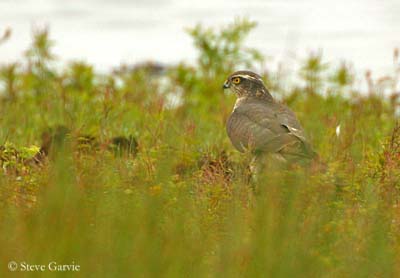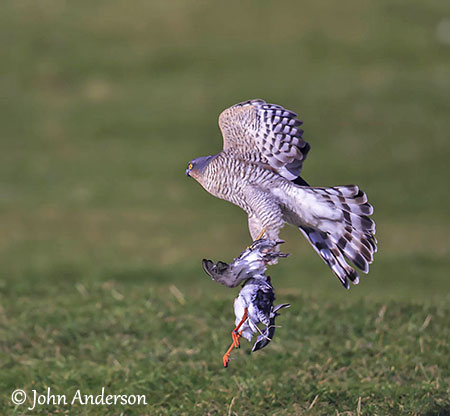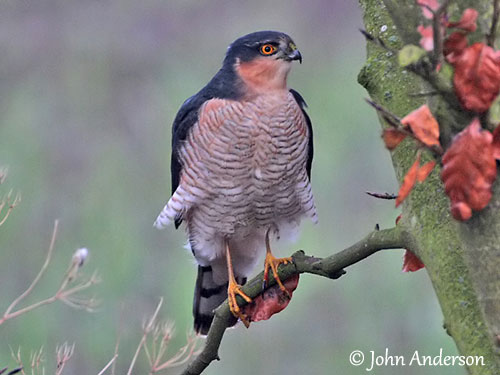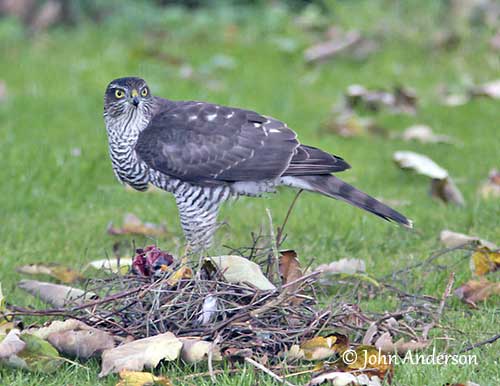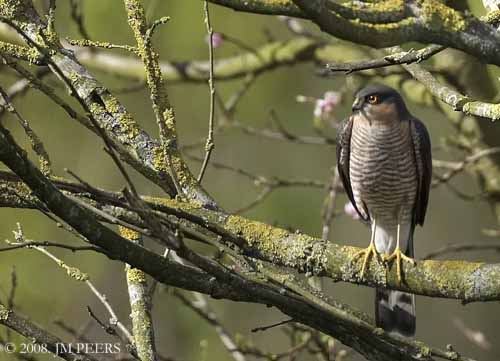
Fr: Epervier d’Europe
All : Sperber
Esp : Gavilán Común
Ital: Sparviero eurasiatico
Nd: Sperwer
Sd: Sparvhök
Photographers:
John Anderson
John Anderson Photo Galleries
Aurélien Audevard
OUESSANT DIGISCOPING
José Luís Beamonte
Pájaros de España
Steve Garvie
RAINBIRDER Photo galleries
Jean Michel Peers
JMPN PHOTOGRAPHIE
Jean Marc Rabby
Des Ailes et des Plumes
Nicole Bouglouan
PHOTOGRAPHIC RAMBLE
Text by Nicole Bouglouan
Sources :
HANDBOOK OF THE BIRDS OF THE WORLD Vol 2 by Josep del Hoyo-Andrew Elliot-Jordi Sargatal - Lynx Edicions - ISBN: 8487334156
THE HANDBOOK OF BIRD IDENTIFICATION FOR EUROPE AND THE WESTERN PALEARCTIC by Mark Beaman, Steve Madge - C.Helm - ISBN: 0713639601
THE COMPLETE BOOK OF BRITISH BIRDS – Written by “Royal Society for the Protection of Birds” experts - Préface de Magnus Magnusson - Michael Cady- Rob Hume Editors - ISBN: 0749509112
GUIDE DES RAPACES DIURNES – Europe, Afrique du Nord et Moyen-Orient de Benny Génsbol – Delachaux et Niestlé – ISBN : 2603013270
ENCYCLOPEDIE DES OISEAUX DE FRANCE ET D’EUROPE – de Peter Hayman et Rob Hume - Flammarion – ISBN : 2082009920
BirdLife International (BirdLife International)
Eurasian Sparrowhawk
Accipiter nisus
Accipitriforme Order – Accipitridae Family
BIOMETRICS:
Length: 28-38 cm
Wingspan: 60-75 cm
Weight: M: 110-195 g – F: 185-342 g
DESCRIPTION:
Relatively small bird of prey, the Eurasian Sparrowhawk is unobtrusive and difficult to observe. This raptor is a very good hunter and its preferred preys are birds, especially small passerines for the male, and mostly thrushes, starlings and even pigeons for the larger female.
Adult male has blue-grey upperparts, including wings and tail.
Underparts are white, barred reddish on flanks and greyer on breast and belly. Underwing has white barred dark grey coverts, and white flight feathers with more conspicuous dark grey bars. Undertail coverts are white. Rectrices are white barred blackish-grey.

The head is blue-grey. Cheeks are reddish. Chin and upper throat are white.
The hooked bill is grey with black tip and yellow cere. Eyes are orange-yellow, surrounded by narrow, yellow eye-ring. Long legs and feet are yellow.
The female is larger than male. She has grey upperparts with brownish wash.
Underparts are white barred grey. She lacks the reddish tinge of the male. She has yellow eyes.
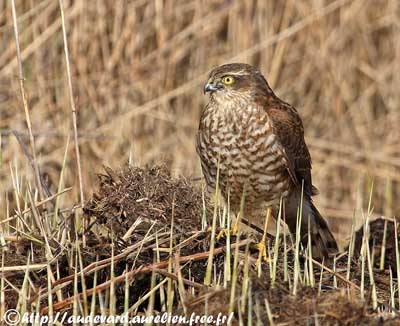
The juvenile resembles female but it has browner upperparts with rufous-edged feathers.
Underparts show broader barring than in adults.
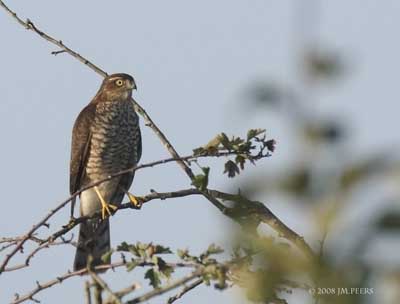
We can find six subspecies: A.n. nisus; A.n. nisosimilis; A.n. melaschistos; A.n. wolterstorffi; A.n. granti and A.n. punicus.
Races differ in size, coloration and barring.
VOICE: SOUNDS BY XENO-CANTO
The Eurasian Sparrowhawk gives “kek kek kek kek” and high-pitched cackling “kailli-kailli-kailli”. The alarm call is a rapid and schrill “kikiki”.
This raptor is very noisy at nest-site and surroundings during the breeding season. Both mates’ contact calls are “ouek ouek ouek” or muffled “tiek tiek tiek”.
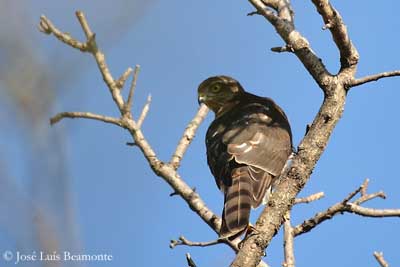
HABITAT:
The Eurasian Sparrowhawk frequents varied types of forests and more open woodlands. It may be seen in urban parks where it finds small passerines at feeders.
This species is visible from sea-level to mountains. In summer, it forages up to the tree-line.
RANGE:
The Eurasian Sparrowhawk is widespread in temperate and subtropical regions of the Old World. Populations of northern Europe and Asia migrate southwards for wintering in North, East and South Africa and in India.
The southern populations are resident and only perform post-breeding dispersions.
BEHAVIOUR:
The Eurasian Sparrowhawk feeds almost exclusively on birds, small passerines and medium-sized preys. The male prefers chaffinches, sparrows and tits, whereas female catches thrushes, starlings and even pigeons.
It also takes some small mammals such as rodents, young hares and rabbits, mice, bats and also insects.
It often hunts in clearings and forest edges, and areas with some trees. It tries to surprise the prey, flying low and using the vegetation as cover.
It also progress by making short flights between several concealed places.
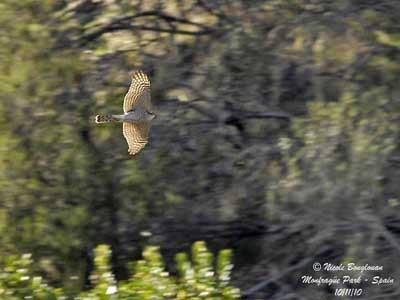
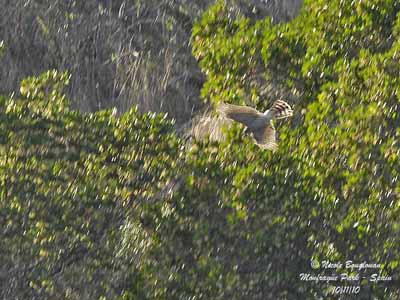
The Eurasian Sparrowhawk usually catches the prey close to the ground. It may pursue the prey during long time. The male takes smaller preys than female, and hunts in more densely wooded areas, thanks to its smaller size.
At the beginning of the breeding season, the male performs deep undulating, rapid flight displays, making fast dives head first and with closed wings, accompanied by high-pitched cackling.
These flights can be intensive, and often end in fast swoop into the vegetation. Both mates can also chase each other through the wooded areas.
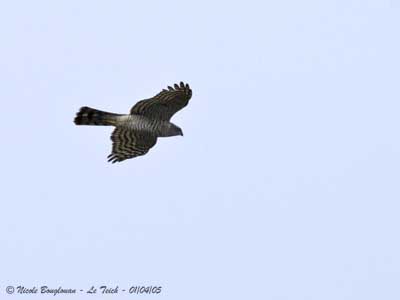
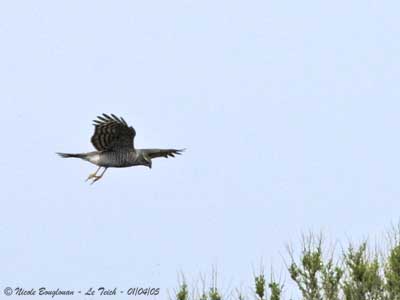
The Eurasian Sparrowhawk is migratory in the northern parts of the range, moving southwards for wintering. It is partially migratory in Europe, and resident in the south of the range.
FLIGHT:
The Eurasian Sparrowhawk performs brief series of rapid wing-beats interspersed with glides. The flight display is deeply undulating with fast dives.
The rounded wings and the long tail are adapted for the flight in forested areas.
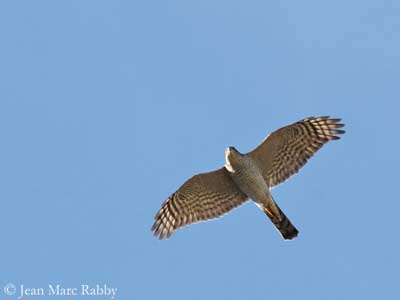
REPRODUCTION:
Laying occurs between April and June, according to the range.
The Eurasian Sparrowhawk nests in wooded areas, coniferous or mixed, and often near a clearing for better and easier access to the nest-site.
Both adults build the nest in tree, in fork or on branch. It is a platform made of sticks, with little or no added vegetation.
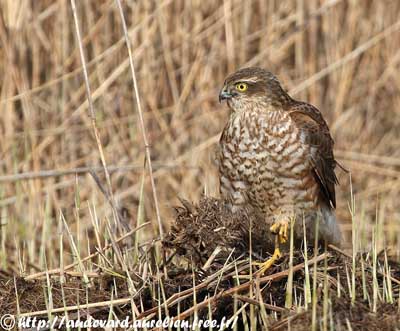
Female lays 3-6 eggs and replacement of clutch can occur twice. Incubation by female lasts 32-34 days. The white downy chicks are fed by the female, with the preys brought by the male.
They fledge at 26-30 days after hatching. Parents feed them for 3-4 weeks more.
Young reach their sexual maturity between 1 and 3 years.
DIET:
The Eurasian Sparrowhawk feeds mainly on passerines for the male and medium-sized birds for the female. They also catch rodents, young hares, rabbits and other small mammals and insects.
